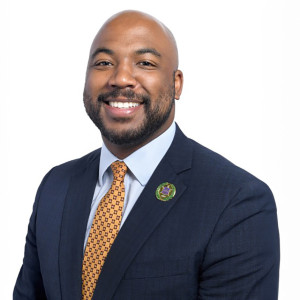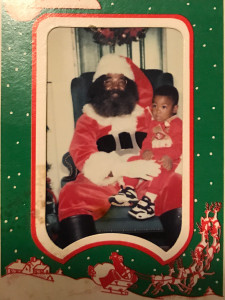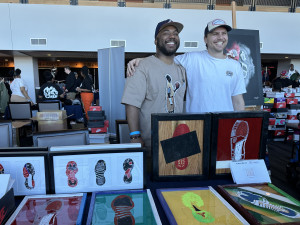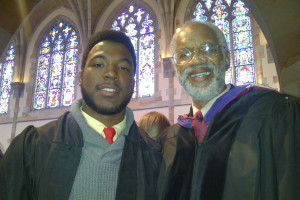"As a student with varied interests, Sewanee helped me see that it was possible to explore many parts of my identity in my professional life."

It’s not hard to tell that Curtis Johnson, C’14, graduated from Sewanee—the clues in his office are everywhere. Though he now works as associate director of college counseling at Woodberry Forest School, a Virginia private boarding school for boys, Johnson is never physically far from pieces of the Mountain. On one of his office walls, he keeps a photo he snapped of Guerry Hall while standing on the roof of Walsh-Ellett as a student. Further down, he displays a painting he created as part of his senior thesis. His Sewanee gown hangs in a corner, close to a YSR foam finger and University pennants. “Sewanee is part of my life daily,” he says.
One particularly meaningful Sewanee keepsake is a framed letter from Robert Black, C’89, associate vice president for athletics – major gifts, who coached the University’s football team from 2007 to 2010. Recognizing Johnson’s talent as a high school quarterback, Black worked with former Assistant Football Coach Josh Taylor to recruit him during his senior year of high school. After Johnson was accepted at the University and decided to enroll, Black sent him a congratulatory note. “He said, ‘You’re going to be a great student-athlete here,’” Johnson recalls. “It was encouraging and affirming.”

footwear off to Santa
Johnson also credits Sewanee Professor of Art Greg Pond, C'95, with helping to bring him to the Mountain. A self-described “sneaker enthusiast,” Johnson had early aspirations of working as a shoe designer, and he met with Pond while weighing college choices. “I learned what it might be like to pursue an art career at a liberal arts school and how I could develop as a professional artist-in-training,” Johnson says. As it turns out, his conversations with Pond had an important secondary effect—they put Johnson’s mom at ease. “She didn’t want me to return home as a starving artist,” he jokes.
On campus, Johnson excelled behind art canvases and in front of game-day crowds. He notes that turf was installed on Sewanee’s Hardee-McGee Field during his senior year—and he scored the first turf touchdown. At his commencement, he received the James Young Perry Sr. C’18 Award, presented to a football player exhibiting exemplary character and sportsmanship. He also spent plenty of time in the studio, painting pieces that explored his identity. His senior thesis presentation, titled Perspective: from a Black Experience, got a standing ovation. “The entire Art Department really challenged me to think about purpose and identity, especially my advisor, [Associate Professor of Art] Jessica Wohl. I’m grateful for their guidance in understanding my voice—not just as an artist, but as a person,” he says.
Football provided lifelong friendships, according to Johnson. He says he also built relationships through his work-study position in the Office of Multicultural Affairs and as a dorm proctor. Looking beyond campus, he joined a Chattanooga chapter of Omega Psi Phi, a predominantly Black Greek-letter organization. Johnson notes that while Omega Psi Phi isn’t officially incorporated at Sewanee, the fraternity has the same motto as the University—from Psalm 133:1. “It’s so interesting to think that this fraternity founded in 1911 on the campus of a historically Black college, [Howard University], shares its foundational beliefs with Sewanee,” he says.
With commencement approaching, Johnson explored options for studying design at the graduate level, but an experience speaking to Sewanee’s Board of Trustees sent him in a different direction. “At that time, there were no student trustees, but Coach Black asked me and another student to share our Sewanee stories with the board,” he says. “After that, several people asked if I’d be interested in working in admissions and talking with prospective students.” Johnson applied for an open admissions counselor position and was quickly hired. “I really enjoyed the idea of getting paid to live among my friends and share stories about our time on the Mountain,” he says. Because his contract was year-to-year, he notes, he had an annual opportunity to evaluate his career plans and change course. “I could always ask myself, ‘Am I in the right place? Is this where I want to give more of myself?’” he says. “’For five years, the answer was always, ‘Yes.’”
Ultimately, Johnson was promoted to senior assistant director of admissions before leaving Sewanee in 2019 to work as assistant director of college counseling at Memphis University School. He took his current position at Woodberry Forest School in 2021. Johnson’s career trajectory may not resemble the path he envisioned while he was a University freshman, but, he says, art and design are still central in his life. Earlier this year, he showcased his project "Marked Sole" at SneakFest Sneaker Expo at Nissan Stadium in Nashville. With "Marked Sole," Johnson uses the linoleum printmaking process to create images of sneaker soles. “Linoleum printing is huge. I love it,” he says. “With linoleum cuts, every print is original art. The paint never lays the same. The print feels like a fingerprint.”

In creating unique prints, Johnson says he channels the same competitive spirit he felt on the football field. “I find myself wanting to make a shot—to make a play with the printing process,” he says. Similarly, he notes, there’s overlap between his work in art and education. “As an artist, I stare at a blank canvas, and I get to have an influence on the story it tells,” he says. “As a college counselor, I listen to people’s stories and help them get on the front end of pursuing their dreams. It’s another place to be creative and imaginative.”
Johnson thanks Sewanee’s liberal arts curriculum for giving him a broad view of career options. “As a student with varied interests, Sewanee helped me see that it was possible to explore many parts of my identity in my professional life. I didn’t have to just be an educator or just be an artist,” he says. “I discovered that education itself is a creative medium, by virtue of the work it involves.”
Sewanee also offered one very large, literal blank canvas—while Johnson was a student, he collaborated with a mentor and Kansas City-based artist Sike Style to paint a Sewanee Tiger mural in the athletic training room at the Fowler Center. In 2018, Style and Johnson joined University students to create a mural in Trenchtown, Jamaica, the home community of Bob Marley, during an outreach trip with the Office of Civic Engagement. “So many people—celebrities like Beyoncé, Jay-Z, Prince Harry, and Meghan Markle—have visited this space in Jamaica that has a mural created by Sewanee students. It’s a cool thought,” he says.
Johnson started supporting the University during his time on staff, and he has given regularly since then. His most recent gifts help sustain the University Art Gallery (UAG). As he explains, Shelley MacLaren, director and curator of academic engagement at the UAG, was a friend and collaborator throughout his years on the Mountain. When, as a staff member, Johnson launched Perspective Sewanee—a forum for prospective students from diverse backgrounds to meet, dine together, and learn from one another—MacLaren co-hosted meals at the UAG. “I really believe in the power that the UAG has, particularly as it relates to conversations about diversity, equity, and inclusion,” Johnson says.

former director of multicultural affairs
Aside from keeping Sewanee treasures in his office, Johnson remains connected to the campus through his service as president of the Benjamin Network, a University organization that empowers and celebrates Black alumni. In his work-study role as a student, he partnered with the late Eric Benjamin, C’73, Sewanee’s former director of multicultural affairs, for whom the Benjamin Network is named. “I carry his spirit with me daily,” Johnson says. The Network meets quarterly and typically hosts a large, on-campus event in late February. Johnson says that the February event always aligns with the theme of Black History Month, and the 2024 gathering will focus on “African Americans and the Arts.”
When recruiting Johnson to come to the Mountain, Robert Black could not have known how much the skilled quarterback would do for Sewanee, but there were hints. “We knew CJ [Curtis] was special when we met him,” Black says. “He was a fine high school player and an even better human being, even as an 18-year-old prospect. These were the types of men we were building the program with.”
Black adds that seeing Johnson’s personal and professional growth “reflects the most important aspect of teaching and coaching, for me. I think Curtis would say that I was a good mentor and friend, but it works both ways. CJ provides inspiration to this old coach every day.” For his part, Johnson says the gratitude is mutual: “I feel like I owe Sewanee so much for what it has given me—and it’ll be a lifetime of giving back.”

